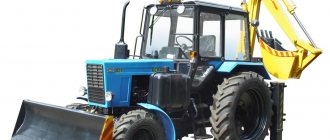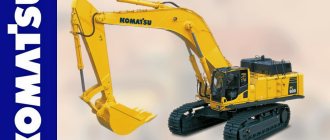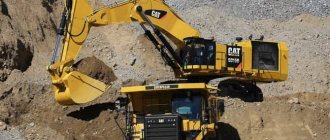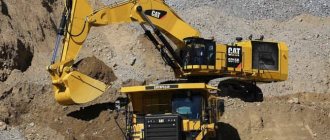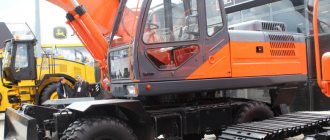If the excavator is equipped with crane equipment, then persons who have been trained and received a certificate in accordance with the rules of Gosgortekhnadzor are allowed to work with it.
Excavators are serviced either by a driver or a driver and an assistant driver. The number of maintenance personnel depends on the power of the machine and production conditions.
As a rule, one driver should work on excavators with a bucket capacity of up to 0.5 m3, and a driver and an assistant driver should work on excavators with a bucket capacity above 0.5 m3. However, if an excavator with a bucket capacity of less than 0.5 m works in difficult conditions, alone, far from populated areas, then an assistant driver serves the machine together with the driver. Conversely, a powerful excavator with a large bucket capacity can be controlled and serviced by one operator if the machine operates in a populated area, close to its park.
When working in several shifts, one of the shift drivers is appointed senior in charge of the machine. The senior driver (also known as the foreman) is responsible for the general condition and serviceability of the excavator, and the shift driver is responsible for each shift.
Drivers of the 5th-6th category operate excavators; assistant drivers have a lower category.
Responsibilities of an excavator driver:
- perform shift production tasks;
- operate an excavator and supervise the work of an assistant;
- take care of the timely supply of the excavator with fuel, lubricants and other materials;
- be responsible for the condition of the excavator;
- manage the maintenance and repair of the excavator in his shift;
- be responsible for compliance with safety regulations;
- When starting work, check the operation of the levers, control pedals, steering wheel, instrumentation, lubrication condition of the main components, oil levels in crankcases, gearboxes and other components, fuel in the tank, water in the water-cooling radiator and working fluid in the hydraulic system tanks ;
- monitor the operation of the engine and its systems, the pressure in the pneumatic system, the operation of clutches and brakes, the winding of ropes on drums, the condition of machine components and the condition of the hydraulic drive, electrical equipment and signal, the tension of chains and tracks, and tire pressure.
If a malfunction is detected, the driver is obliged to immediately stop work and eliminate the malfunction. If this is not possible, he must report the malfunction to the person responsible for the operation of excavators in the organization that owns the machine.
Responsibilities of an assistant excavator driver:
- lubricate excavator components;
- monitor the operation of the excavator and warn the driver about malfunctions;
- monitor the cleanliness of the excavator, the safety of tools and equipment;
- Participate in excavator maintenance.
After the shift, the driver, together with the driver’s assistant, is required to prepare and hand over the car to the shift workers. To do this, they thoroughly clean the excavator from dirt and dust and, if possible, wash it, check the fastening of the main components, eliminate faults discovered during operation, lubricate the components, fill the machine with fuels and lubricants and water, and after all, make an entry in the shift note. journal about the work of the excavator indicating the volumes performed, duration of work, reasons for downtime, etc.
The operator receiving the excavator is obliged to check the operation of the excavator mechanisms at idle. After this, both drivers sign in the shift log about the delivery and acceptance of the excavator.
The driver and his assistant should remember that for trouble-free operation of the excavator they need to study and strictly follow the operating instructions for their excavator.
Document type: Instruction
To save a sample of this document to your computer, follow the download link.
Document file size: 19.0 kb
Technical characteristics of ECG-5A
The EKG-5A excavator is designed for temperate climates with temperatures ranging from -40 to +40°C, as well as for tropical climates at an altitude of no more than 1,000 m above sea level. Let us list its individual technical characteristics.
| Largest scooping radius | 14.5 m |
| Radius of scooping at standing level | 9.04 m |
| Maximum scooping height | 10.3 m |
| The largest unloading radius | 12.65 m |
| Maximum unloading height | 6.7 m |
| Clearance under the turntable | 1.85 m |
| Average specific ground pressure when moving | 205/162/127 kPa |
| Estimated cycle time | 23 s |
Area of use of EKG-5A excavators
These powerful machines are used to advantage in the mining and processing industries. They are indispensable for digging soil and solid fractions, minerals. Excavators are satellites of mining, metallurgy, coal mining and the construction industry.
Despite their power, EKG-5A machines have dynamic handling, and their maintenance and service does not cause much trouble.
Among the manufacturers of EKG-5A excavators, the leading positions are occupied by:
- JSC "Mining Machines";
- JSC "Uralmash";
- JSC "Izhora Plants"
ECG-5A device
The model consists of the following components: a rotating part, which includes a rotating platform with mechanisms located on it, and working equipment; undercarriage, consisting of a lower frame, two track frames with wheels and track chains; running gear, ring gear, roller circle.
All mechanisms on the EKG-5A platform are covered by the body. For ease of repair and installation of mechanisms on the platform, the roof of the body has removable panels. The location of the main units and components of the machine provides easy access to them for installation, dismantling and repair work. Most mechanisms and components have a block design and are interchangeable, which makes it possible to use the aggregate-unit method for repairs.
Photo source: techstory.ru The weight of the ECG-5A is 196 tons
Excavators ECG: instructions, reviews, photos
EKG excavators traditionally hold a strong position in the fleets of large mining enterprises in Russia. This is a powerful technique designed for a direct range of work with cuts. Some excavators are obsolete, many of them are more than 30 years old, however, they continue to perform their tasks effectively. This durability is explained by the simple classical design of ECG excavators and the maximum use of metals in the design.
Purpose of ECG excavators
The abbreviation ECG already indicates the main application of this technique - Crawler Quarry Excavator. The main task performed by excavator equipment is the development of quarries with soils of various hardness categories. To accomplish this, the excavator performs a complex of the following works:
- development of a quarry section;
- opening of mineral deposits;
- loading and moving mined rocks into transport.
Excavators of the EKG type are used mainly in open-pit mining enterprises and in the construction industry for extracting building materials and performing earth-moving work.
Basic device of ECG excavators
ECGs are designed on the principle of a simple rope excavator. These are tracked, full-rotary, single-bucket electric machines. Some models use an electric-diesel power unit. The standard working equipment of any of the models - a straight mechanical shovel - can be extended, which is necessarily noted in the model designation.
The basic design for ECG excavators is created according to the traditional design and is used in all modifications with standard elements:
- undercarriage, consisting of a frame, tracks, final drives and ring gear;
- central axle with roller circle;
- a rotating platform on which the driver’s cabin, turning mechanisms, winches, electrical equipment and racks are located;
- a boom with ropes that lift and lower the boom, open and lift the bucket;
- an opening bucket with removable teeth, which is connected to the boom by a handle made in the form of two beams.
The separate drive of both parts of the crawler allows heavy equipment to turn on the spot with a minimum radius and maintain stability when working on sloping terrain.
Features of the main modifications of ECG excavators
In the designation of modifications of ECG excavators, the number following the abbreviation indicates the volume of the bucket in cubic meters. The bucket capacity of EKG excavators varies from a minimum of 4 cubic meters. and maximum – 46 cubic meters. Additional letters in the series indicate either the name of the manufacturing plant or structural features.
ECG-5A
The most popular model from 1980 until today. The machine has proven itself to be suitable for working in the most difficult climatic conditions. In addition, the coordinated operation of mechanisms and components allows this modification of the ECG to cope with tasks of various levels and soils of all categories. Although this modification is already quite outdated, it is still in use. This is due to the fact that there are no difficulties in operation and maintenance. In addition, consumable spare parts and parts are available to the mass consumer.
- EKG-5D - equipped with a primary diesel power unit, used in quarries where there is no access to power lines.
- EKG-5V - the bucket of this model is equipped with pneumatic impact teeth, which are used in the development of rocky and coal rocks.
ECG-10
The main difference from the previous model line is a more powerful breakout lift and an increased bucket capacity from 8 to 10 cubic meters.
- EKG-10M - is characterized by a more expanded bucket design, which allows you to fill a volume of 11.5 cubic meters with lighter rocks. Designed for use in coal mines.
- EKG – 8US – bucket capacity 8 cubic meters. At the same time, it is distinguished by elongated working bodies and is designed to perform loading or development work in hard-to-reach levels.
ECG-12
This modification does not apply to mass models. Several units were produced.
EKG-12V – is equipped with a bucket with pneumatic hammer teeth. Operated in rock quarries that have been mined using explosive force.
ECG-15
In the basic design it is equipped with elongated working bodies. The main application is in the development of overburden rocks and soils and their subsequent loading into road and rail transport.
EKG-18 – has 170 tons of lifting and 80 tons of pressure force.
Models EKG-20, EKG-12 are excavators, photos of which are more likely to be seen than the equipment itself, concentrated in the hands of private companies and for several decades and regularly performing its functions.
Reviews of ECG technology and prices for mass-produced models
The operation of ECG excavators has shown its reliability and unpretentiousness in different operating conditions. The owners explain the durability and reliability of the ECG by the fact that alloy steel is predominantly used in the design. Malfunctions caused by wear and tear of parts can be easily eliminated due to the availability and low cost of consumables and spare parts.
EKG excavators are expensive special equipment. But they are also used, as a rule, in large projects. The price for ECG machines that are not older than 25 years averages 50,000,000 rubles. The cost of more “fresh” models can reach 200,000,000 rubles.
Video
Working equipment, chassis
The EKG-5A working equipment includes a bucket, a bucket handle, a bucket opening mechanism, a boom with a pressure mechanism and a two-legged stand. The lower end of the boom rests on the thrust bearings of the turntable, and the upper end is supported by a rope pulley. The rotating platform is equipped with a lifting winch, two rotating mechanisms, electrical equipment, a pneumatic system, a two-legged stand, a boom winch and a body.
The driver's cabin is located in the front right part of the platform. The turntable rests on the undercarriage through a roller circle and is connected to it by a central axle. A high-voltage current collector is installed between the rotary and lower frames. The undercarriage consists of a lower frame, a caterpillar track, a ring gear with a lower ring rail, a final drive with a brake, a hydraulic brake control system, and caterpillar gear shift couplings.
Photo source: techstory.ru Photo ECG-5A
The EKG-5A bucket consists of front and rear walls, a bottom, a rocker arm and a cage with an equalizing block. The front wall is made of high-manganese steel and is equipped with five removable teeth made of the same steel. The front wall and teeth are surfaced with a hard alloy of the “Sormite” type. The bucket body is connected with pins to the rocker arm and the bottom. The bucket handle consists of two welded rectangular beams made of low-alloy steel sheets with welded solid-rolled slats. The boom is a welded metal structure with a box-section. The boom of the EKG-5A quarry tracked vehicle is equipped with a pressure mechanism, head blocks, boom rope blocks and a bucket opening winch. For stability, the boom is secured to the turntable with side rods.
Electric drive EKG-5A
The pressure mechanism is driven by an electric motor, on the shaft of which a gear is attached, which meshes with the gear of the intermediate shaft of the gearbox. The rotary mechanism consists of two identical units. Each of them has a vertical electric motor with a flange resting on the gearbox housing. The running mechanism is driven by an electric motor mounted on the front wall of the lower frame.
Photo source: techstory.ruThe volume of the EKG-5A bucket is 5.2 cubic meters
The pneumatic system is designed to control lifting, slewing, pressure brakes, purging electrical equipment from dust, giving an audible signal and driving various pneumatic tools with compressed air from a single-stage two-cylinder compressor with a supply of 580 l/min with a working pressure of 0.7 MPa. The EKG-5A hydraulic system is designed to control the brake of the running gear and the track switching mechanism. The main parts of the hydraulic system are located on the rear wall of the lower frame.
The machine receives power from a high-voltage switching point. The quality of power supply must be ensured by the consumer in accordance with the standards of the current regulatory and technical documentation. Power consumption in half-hour mode is 250-275 kW with a weighted average power factor of 0.6. For power supply from the connection point, a high-voltage cable KShVG-Zx16+1x6 for temperate climate conditions or KShVG-T-Zx25+1xYu for tropical climate conditions is recommended. To control the high-voltage electric motor Ag-M (a five-machine converting unit) and the auxiliary power transformer Tr1, a small-sized high-voltage switchgear RU with a general disconnector, an oil switch for a trip current of 1.25 kA, having a manual drive, and fuses on 8 A or 16 A at a supply voltage of 6,000 V or 3,000 V, respectively.
Single-line electrical diagram
Relay current protection, as well as protection against lightning overvoltages and metering of consumed electricity consumption is provided by the consumer at the electrical substation or at the switching point. The housing is grounded to the quarry grounding circuit through the grounding conductor of the KShVG cable. The electric motors of lifting, pressure, rotation, and travel are powered by a generator-motor system with direct current controlled by power magnetic amplifiers UK-UMSP, UK-UMSN, UK-UMSV by cam command controllers KKP, KKN, KKV.
The EKG-5A control system contains blocks and assemblies that ensure the stability of the mechanical characteristics of the main drives when the temperature of electrical machines changes: current limiting blocks - UK-BTOP, UK-BTON, UK-BTOV; unit for stabilizing the excitation currents of the main drive motors - UK-BSTV; automatic digging unit - UK-BAK. The excavator provides monitoring of the insulation state of the 220 V AC power supply RU-R, as well as power and DC control circuits.
General and private parameters
Common parameters
| Options | Meaning |
| Bucket capacity, m3 | 5, 2 |
| Scooping radius, m | 14, 5 |
| Scooping height, m | 10,3 |
| Clearance under the turntable, m | 1, 85 |
| Working weight, t | 196 |
Bucket parameters
| Weight, t | 9, 935 |
| Length, m | 2, 45 |
| Width, m | 2, 19 |
| Height, m | 2, 56 |
Bucket Handle Features
| Weight, t | 7, 95 |
| Length, m | 7, 915 |
| Width, m | 1, 774 |
Rack options
| Weight, t | 3, 48 |
| Length, m | 6, 45 |
| Width, m | 1, 4 |
Turntable parameters
| weight, t | 18, 9 |
| Length, m | 8, 1 |
| Width, m | 5, 0 |
| Height, m | 1, 2 |
Characteristics of the lower and crawler frame
| Index | Bottom frame | Track frame |
| Weight, t | 10, 5 | 5, 45 |
| Length, m | 3, 0 | 5, 5 |
| Width, m | 3, 0 | 0, 75 |
| Height, m | 1, 68 | 1,0 |
Cabin parameters
| Weight, t | 1,1 |
| Length, m | 2, 36 |
| Width, m | 1, 35 |
| Height, m | 2, 76 |
Engine technical parameters
The network motor is the heart of the entire excavator mechanism. It has a power of 250 kW and its weight is more than 2 tons. In addition to the network engine, which is represented by the Ag-M model, the excavator is equipped with three more driving units.
Engine stroke and pressure
| Weight, t | 0, 86 |
| Length, m | 1, 28 |
| Width, m | 0, 59 |
Swing motor
| Weight, t | 0, 93 |
| Length, m | 1, 32 |
| Width, m | 0, 57 |
Lift motor
| Weight, t | 3, 5 |
| Length, m | 1 ,85 |
| Width, m | 0 ,96 |
Rope parameters
The EKG-5A excavator contains ropes that work in three directions.
| Purpose of the rope | Diameter, mm | Length, m | Breaking force, kgf |
| Bucket lifting | 39, 5 | 58 | 94623 |
| Boom lift | 30 | 125 | 57 300 |
| Opening the bottom of the bucket | 11, 15 | 10, 5 | 6255 |
Electrical equipment
The power supply and operation of the system mechanisms is carried out from a high-voltage point. For half an hour of continuous operation, the EKG-5A consumes electricity from 250 to 275 kW.
Two types of cable are used in excavator operation:
- KShVG-3 x 16 + 1 x 6;
- KSHVG-T - 3 x 25 +1 x 10.
The source of control for the electric motor is a switchgear, which is equipped with:
- a switch that can withstand current up to 1.25 A;
- manual drive;
- fuse for 8 and 16 A.
Electrical equipment diagram of the EKG-5A excavator
For safety reasons, the EKG-5A excavator has a reliable grounding system.
It is carried out along the contour through a special core. Stable and balanced operation is ensured by appropriate blocks and units.
